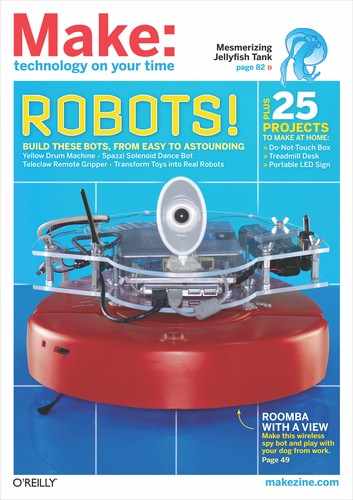REMAKING HISTORY
The Daniell Cell
Make the electric battery that powered the scientific revolution.
SEVERAL OF THE PROJECTS FEATURED
previously in this column were battery powered. Humphrey Davy, who developed the arc light (Volume 20), and Samuel Morse, inventor of the telegraph (Volume 23), used voltage produced by chemical reaction.
In 1800 Alessandro Volta made the first apparatus that turned chemical energy into a stable, long-lasting, and constant electrical voltage (Volume 24). But it was hard to use because the chemical reaction quickly corroded the parts.
In 1836, English chemist John Frederic Daniell invented a dependable, easy-to-use battery, so good that it was used in one shape or another until the 1950s.
Like Benjamin Franklin, Daniell was a polymath and prolific inventor, as well as a horticulturalist and meteorologist. He taught chemistry, invented heat and humidity gauges, and wrote the Introduction to Chemical Philosophy (1839).
Inside the Daniell cell, electrons are transferred from the zinc electrode to the copper one, producing slightly more than 1 volt. Unlike Volta’s early batteries, the Daniell cell made use of 2 separate but electrically connected electrolyte solutions. This method radically lengthened the life of the cell.
In this edition of Remaking History, we build a Daniell cell battery using common hardware-store chemicals.
No matter how big or small it’s made, each zinc-copper Daniell cell produces about 1.1 volts. It takes 2 Daniell cells connected in series to power an LED.

Getty
JUICE MAKER![]() English polymath John Frederic Daniell (1790–1845) invented the Daniell electric cell in 1836, a radical improvement on the Volta cell. His brilliant career ended when he died of apoplexy at 55 at a meeting of the Royal Society, to which he’d been elected at 23.
English polymath John Frederic Daniell (1790–1845) invented the Daniell electric cell in 1836, a radical improvement on the Volta cell. His brilliant career ended when he died of apoplexy at 55 at a meeting of the Royal Society, to which he’d been elected at 23.
MATERIALS
For each Daniell cell:
Copper strip, ¾"×3" A 3"-long copper tube will also work.
Zinc strip, ¾"×3" You can buy zinc sheet metal at some hardware stores. Alternatively, you can harvest zinc from the outer shell of a D-size non-alkaline battery. Carefully open the battery with a hacksaw or rotary tool (Dremel) equipped with an abrasive cutting-wheel attachment. Scoop out the black powder with a spoon and remove the carbon rod inside. Clean the zinc and then cut it to size.
Mason jars and lids, quart-size (2)
Plastic hose, 1" diameter, 8" long
Cotton balls (6)
Copper sulfate In its pentahydrate form, it’s typically found in the drain cleaner section of hardware stores. Manufacturers include Rooto and Roembic.
Zinc sulfate Available in garden centers and hardware stores as moss remover.
Table salt and distilled water
Alligator clip leads (2)
LED (optional)
TOOLS
Voltmeter
Glass stirring rod
Scale for weighing chemicals
1. Make the copper sulfate solution.
In a Mason jar, dissolve about 50 grams of copper sulfate in a pint of distilled water. The copper sulfate will be slow to dissolve, but if you stir or shake the covered jar long enough, most of it will eventually go into solution.
2. Make the zinc sulfate solution.
In a second Mason jar, dissolve 50 grams of zinc sulfate in a pint of distilled water.
3. Make the salt water solution.
In a bowl, dissolve 25 grams of table salt in a cup of distilled water.
4. Make the saline bridge.
Place two cotton balls in one end of the 1"-diameter plastic tube. Fill the tube completely with salt water, and plug the other end with 2 more cotton balls.
5. Position the saline bridge.
Put one end of the bridge in each of the Mason jars. Note that some salt water may leak out of the bridge. Some leakage is acceptable; however, there must be a continuous salt water connection from one Mason jar to the other.
6. Insert the metal strips.
Attach the metal strips to the alligator clips and voltmeter. Place the copper metal strip in the copper sulfate solution and the zinc strip in the zinc solution (Figure A). With the bridge in place, the voltmeter should read 1.0 to 1.1 volts (Figure B). You’ve got a Daniell cell.
7. Prepare a second Daniell cell.
8. Attach the 2 Daniell cells in series.
Connect cell 1’s zinc strip to cell 2’s copper strip. Then connect cell 1’s copper to the LED’s positive (long) lead, and cell 2’s zinc to its negative (short) lead (Figure C). If you’ve done it right, the LED will light. Congratulations, you’ve made a battery! ![]()
Gregory Hayes; Gerry Arrington (C)
Unlike Volta’s cell, Daniell’s used 2 separate electrolyte solutions, which radically lengthened its life.
![]() CAUTION: Wear rubber gloves and splash-proof eye protection when mixing chemical solutions. Do NOT pour any chemical solutions down the storm sewer. Empty them in a utility drain or toilet.
CAUTION: Wear rubber gloves and splash-proof eye protection when mixing chemical solutions. Do NOT pour any chemical solutions down the storm sewer. Empty them in a utility drain or toilet.
William Gurstelle is a contributing editor of MAKE. His new book, The Practical Pyromaniac, is available in the Maker Shed (makershed.com) and at other fine booksellers.












